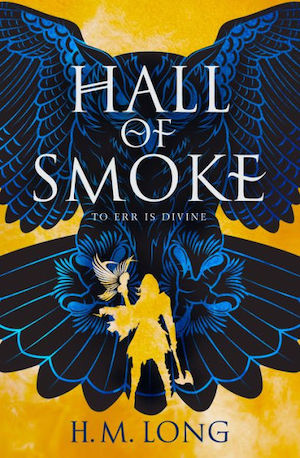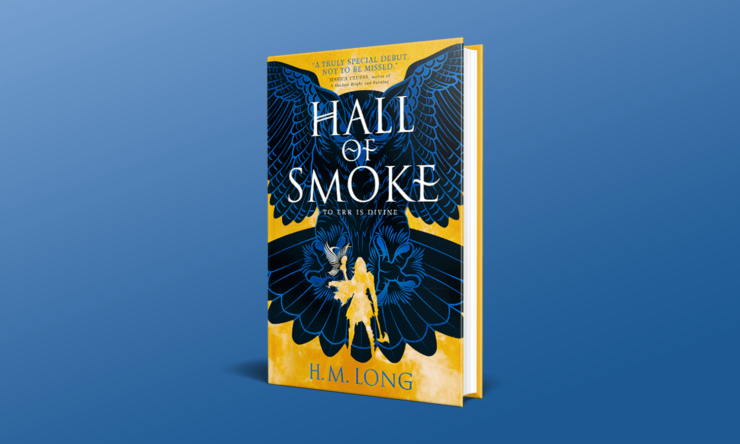The basic four archetypes for a D&D-like party are the Fighter, the Rogue, the Wizard and the Cleric. In secondary world fantasy novels, the first three are very well represented, to the point of many variations and subclasses and versions of same. But the Cleric is far rarer. It’s not that there are none, mind you, but they are far, far less common as protagonists. Why is that? That is perhaps beyond the scope of this piece, but I think I know why
Evil priests of dread Gods as antagonists and cannon fodder to kill? That’s common. But a pious holy woman dedicated to her Goddess as a protagonist? Much fewer in number, especially when you are looking at female protagonists. And that is why H.M. Long’s Hall of Smoke is welcome, as we get front and center Hessa, a priestess of a Goddess of War.
As we start the novel though, Hessa is more than estranged from Eang, and actively trying to seek atonement for failing to heed her goddess’ command. Years ago, she was granted a vision of someone, a stranger, she was commanded to kill when she finally met. She failed to do so for reasons not immediately clear but that are teased out in the course of the novel, and now seeks reconciliation with her Goddess. A devastating attack on her home sends her on a quest across the North, seeking the man that she failed to kill—Omahaut. Along the way, Hessa will learn painful truths about herself, her goddess, and her world.
Hall of Smoke is then a story of redemption, of growth, of discovery, of questioning one’s beliefs and trying to come to find what one does believe in, and acting on those beliefs.
Buy the Book


Hall of Smoke
With the inciting incident sending Hessa on the road, we get a great opportunity to see the North, get a slice of the world, and to have Hessa interact with a variety of characters and entities, and explore the world that the author has built. (The map in the book is extremely useful, as we try to figure out whys and wherefores of the political events.) The political setup, aside from the religious and spiritual aspects, reminds me of a lot of Imperial Rome, but from outside its orders. The Arpa are the Rome analogues, down to marching in legions and building walls and forts. They are the “center of civilization” and turn out to be a plot driver on several levels, more than Hessa first realizes.
The interesting bit that Long does here is that she sets up the Eangen, Hessa’s people, and the Algatt, their traditional enemies, on the borders of Empire as rivals who deal with the Empire and other powers bordering the Empire. These relations go from the political to the religious, there is a good unity of relationships here that only deepens as we learn more. So the Empire might consider the Eangen and Algatt and the Souldern barbarians and use them as a resource, but they have cultures, societies, deities and clashing points of view. We get to see the Empire from their perspective, as an external factor and force that impinges on them. The novel does not take us into the Empire, it stays in borderlands and hinterlands and just has the Arpa intruding on those lands, on those societies, on those lives. The Netflix show Barbarians comes to mind down to the fact that some of the Northerners, just like in the Roman World, do time and service in Arpa’s legions as auxiliaries. The book definitely has a lot to say about cultural imperialism and the impositions of belief systems (and Gods) on a population and how that point of view can change and influence societies.
And in a world such that Long has built, where the Gods are real, what that belief is, whom to believe, whom to worship and respect come to be the central questions of the novel. This would be a potent narrative if Hessa were merely a fighter of some stripe (and she is ferocious on the battlefield, as befits a priestess of the Goddess of War) but she is devoted and aligned to a Goddess. So the novel explores questions that only a fantasy novel can really provide—what does it mean to be devoted to a divinity whose existence is undeniable whether you worship her or not? What happens when that trust, that bond, that devotion is tested, even betrayed? How does one navigate pledging oneself to a deity in a world where such entities are in conflict, both personally and through their followers? When you have Old Gods, New Gods and Elder Gods and their relationships are new to you, who do you trust and whom do you ultimately serve? And whom should you serve, once it is clear that the world is not the simple narrative that you had thought? The trials, tribulations and adventures of Hessa bring these questions to light for her in a real and consequential way.
I think this here again is the value of this story being a cleric, a priestess, rather than, say, a fighter or a rogue or wizard. If Hessa were one of those, particularly a fighter, the political strands of the plot of the narrative could well stand. Attack on her community, try and find the remnants of her people, deal with the existential threat to the Eangen. No matter how pious they really were , the conflict on the theological level would not work anywhere near as well. Hessa may not be very bookish or learned as a priestess (she is not a High Priestess after all) and she has to quickly learn some things about the world, but her nature as a Priestess allows the room for this story to be martial, and spiritual, and theological. The choices she makes, the difficult decisions she faces at points that tie into those beliefs, really resonate with her character.
Although the tech level is higher (Iron Age, not Bronze Age), the touchstone as I was reading the novel was the late Greg Stafford’s roleplaying game world of Glorantha. That is a world of manifest Gods in a cubical world, where everyone is devoted to some divinity or another. All Gods are real although not necessarily equal, and there is conflict on plans both mythic and mortal. The High Halls, an upper plane of the Gods in this novel, felt very much like the Hero Plane of Glorantha, an otherworldly place that certain mortals might dare to travel, and in the course of events, Hessa does wind up there, and finds out not only much about her current situation, but the nature of divinity and the universe itself. The relative strengths of Gods and how they fare in regards to how their worshipers are doing, showing the need for Gods for worshipers and vice versa, is a strain that is Gloranthan but runs through a fair number of fantasy novels. Long’s contribution here to those ideas involve revelations of what the nature of all these various kinds of Gods are, and what they ultimately want.
But the author keeps it grounded and tangible and human when needed. Sure, Eang might be in a conflict with other divinities, and her son Ogam is an unreliable ally, and there is an overarching plot involving the rising power of a God, as well as imprisoned ones, weakened ones and other such mythic entanglements, but Hessa’s story, even as she navigates all this, is a very human tale and ultimately. It is a story of Hessa coming to learn, for herself, who and what she believes in as a Priestess, and what those around her believe. The real social relationship web of conflicting loyalties and tensions runs within Hessa and without her. That web runs through the book even as the plot has Hessa travel through it. For all that she outwardly and inwardly thinks she is alone, she finds, rediscovers and maintains connections on her travels and it is those connections that really drive her personal change. The strong focused first person perspective we get in the novel leans into that.
Not to worry, though, For all of the theological and spiritual conflicts in Hessa’s adventures, making Hessa a cleric of a Goddess of War means that she is very much an action protagonist and there are some excellent action sequences throughout the book, leavening the sometimes somber and reflective and even melancholic aspects of the book (a priestess concerned if not doubting about the state of affairs with her Goddess and the world is not very cheerful) with well written action sequences. There is a good physical sense to the writing, be it making the climb of atonement, fighting in a pitched battle, or a deadly confrontation with two deities on the hunt.
There is a throughline of a secondary character’s story that Hessa’s intersects that really ties the book together. The character’s God has been killed (Gods can be undone, an abiding concern throughout the book). Hessa’s worry about the characters’ state and safety, and to avoid being subsumed by the spiritual threat, is that the character find another God to pledge himself to. Hessa is not a missionary cleric in wanting the character to pledge himself to Eang (with the exception of one, there really aren’t proselytizing faiths in this world, and that faith’s practices are definitely seen in a very negative light) but her concern is that the character find *some* other Northern deity to believe in, for their own protection and well being. That is what a priestess or cleric is for. Not just to smite foes almost as well as true fighters, or to call on divine power (Hessa does both of these) but also to explore and provide a spiritual anchor, guide, signpost. The fact that she herself is wandering, often lost and on a journey of her own to find security is beside the point. She provides that role for others, even as she looks for her own place. Long understands what priestesses and clerics in fantasy stories could be doing besides smiting foes natural or unnatural alike.
In the end, the novel does again something rather unusual in that it is a finished story in one volume, telling this rather crafty and well-written tale completely. I can see how there could be additional books in a series: there is plenty of the world only mentioned and not seen but the story here fits the length of the book While Hessa’s story has a completely solid off ramp here, I would be most interested in reading further, especially given the new state of the world by the end of the novel.
Hall of Smoke is available from Titan Books.
An ex-pat New Yorker living in Minnesota, Paul Weimer has been reading sci-fi and fantasy for over 30 years. An avid and enthusiastic amateur photographer, blogger and podcaster, Paul primarily contributes to the Skiffy and Fanty Show as blogger and podcaster, and the SFF Audio podcast. If you’ve spent any time reading about SFF online, you’ve probably read one of his blog comments or tweets (he’s @PrinceJvstin).










